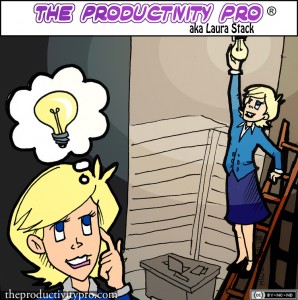“Know the true value of time; snatch, seize, and enjoy every moment of it. No idleness, no laziness, no procrastination: never put off till tomorrow what you can do today.” ― Philip Stanhope, 4th Earl of Chesterfield
Here is the roundup of activity from Laura Stack’s blog, columns, podcast, and other featured articles. Scroll down to read the complete roundup of productivity resources to help you create Maximum Results in Minimum Time.
This week on the Blog
Activating Yourself: Converting Thoughts and Ideas into Action
 You see it everywhere, from corporate boardrooms to Hollywood: the constant recycling and refining of the same ideas, with anything unique usually plowed under before it has time to bloom. We’re on, what, the third reboot of the Batman movie franchise in 20 years? And it seems everything on the store shelves is “new and improved” (as opposed to “old and lousy,” per Mike Stivic on the original All in the Family TV series). What ever happened to just new? Not so long ago, corporate America prized originality.
You see it everywhere, from corporate boardrooms to Hollywood: the constant recycling and refining of the same ideas, with anything unique usually plowed under before it has time to bloom. We’re on, what, the third reboot of the Batman movie franchise in 20 years? And it seems everything on the store shelves is “new and improved” (as opposed to “old and lousy,” per Mike Stivic on the original All in the Family TV series). What ever happened to just new? Not so long ago, corporate America prized originality.
Then of course, we were mowed down by the dot-com implosion and the Great Recession; so while we may not have an excuse for our apparent lack of novelty and creativity, at least we have an explanation. There are exceptions, of course; Apple springs to mind. But today, modern business moves so fast many of us prefer to rely on proven success, both in terms of products and processes. We reuse the same ideas because we feel we don’t have time to take a chance on anything new—or we just don’t want to bother.
The problem isn’t that we don’t have new ideas; we just don’t act on them. According to speaker and TV/radio host Mel Robbins, if you don’t match an impulse with action within five seconds, you kill the idea. She calls it the Five Second Rule, like the one I practice when my son drops a cookie on the floor.
Even just writing yourself a note is enough, Robbins says, as long as you marry the idea with something physical. Otherwise, we kill our own ideas by the dozens, simply by not providing the “activation energy” required to plant the idea-seed, much less nurture it. Thinking about them is all well and good, but you won’t actually accomplish anything if you think too long. At some point, you must move from meditation to motion. (I’m sure my regular readers recognize a theme here!) Even if the idea doesn’t work out in the end, at least you gave it a chance.
And don’t assume the idea will never work, even if it fails today. Consider Charles Babbage’s Difference Engine No. 2, a mechanical computer designed in the late 1840s. Babbage couldn’t find a power source strong enough to run it then, nor a government willing to pay for one; but more than 130 years later, when hooked up to a modern engine, a faithful replica of Babbage’s design did exactly what he had designed it to do: rapidly add, subtract, and multiply complex numbers.
Where might we be now if the engineers of 1850s Europe had had the resources to jumpstart the computer age a century early?
Teamwork and the Five-Second Rule
If you think of something that will save time for your team, such as an idea for significantly streamlining a process, walk over to a team member or the team leader, open your mouth, and tell them about it—as quickly as possible. Remember, if you take longer than five seconds, you’ll probably chicken out. So don’t take a moment to psyche yourself up; get right to it.
Speed is a virtue in the modern business arena. Tell others about your ideas, so you can put the ideas in their heads, too. The more people you tell your idea, the more likely the idea will survive. You’re almost certainly not the very first person in history to have the idea; however, you may implement it before or better than anyone else.
Even if no one likes your idea, at least it had a fighting chance, and lived long enough to face the litmus test of popularity and value. You can’t succeed unless you’re willing to fail… maybe a lot, though that’s not inevitable. And remember: like the Difference Engine, some variation of your idea may still work if circumstances change. Technology may advance enough that, suddenly, several inventors make the idea work at about the same time. It happened with steamships, radio, the telephone, and possibly the airplane.
If you’re in no position to apply the five second rule to your ideas in any other way, then pin down the idea with a pen: in my father’s famous words, “If you think it, ink it.” That’s a simple action you can marry to the thought, until you have time to consider it further.
Special Bonuses Available Jan. 18-22 on my new book
Visit www.3TLeadership.com for details
 Doing the Right Things Right details precisely how today’s leaders and managers can obtain profitable, productive results by managing the intersection of two critical values: effectiveness and efficiency. Effectiveness, Stack says, is identifying and achieving the best objectives for your organization-doing the right things. Efficiency is accomplishing them with the least amount of time, effort, and cost-doing things right. If you’re not clear on both, you’re wasting your time.
Doing the Right Things Right details precisely how today’s leaders and managers can obtain profitable, productive results by managing the intersection of two critical values: effectiveness and efficiency. Effectiveness, Stack says, is identifying and achieving the best objectives for your organization-doing the right things. Efficiency is accomplishing them with the least amount of time, effort, and cost-doing things right. If you’re not clear on both, you’re wasting your time.
Don’t forget to sign up for the free webinar on January 19. Read More.
Podcast
Visit with me this week while I talk about building family time into your schedule.
© 2015 Laura Stack. Laura Stack, MBA, CSP, CPAE is an award-winning keynote speaker, bestselling author, and noted authority on employee and team productivity. She is the president of The Productivity Pro, Inc., a company dedicated to helping leaders increase workplace performance in high-stress environments. Stack has authored seven books, including her newest work, Doing the Right Things Right: How the Effective Executive Spends Time (Jan. 2016). She is a past president of the National Speakers Association, and in 2015 was inducted into its exclusive Speaker Hall of Fame (with fewer than 175 members worldwide). Stack’s clients include Cisco Systems, Wal-Mart, and Bank of America, and she has been featured on the CBS Early Show and CNN, and in the New York Times. To have Laura Stack speak at your next event, call 303-471-7401 or visit her website.



LOVE the post, Laura. It does, indeed, seem like most things nowadays are just continuations of old innovations. Taking action on ideas is so crucial – even if you risk presenting a bad idea! It’s like Seth Godin says, bad ideas are part of the game and that’s how you get to good ideas.
Agree! Oh man, I’ve had some bad ones too! Some things that didn’t work out well at all…NEXT! Can’t let it get you down or remain fearful, or you might just miss that next great idea. Fear paralyzes so many people into not doing anything.
“…match an impulse with action within five seconds, (or) you kill the idea.”
“If you think it, ink it.”
These are very encouraging and insightful concepts! I had to write a quick “Thank-you,” or that thought would have been gone! 🙂
Thanks Karen! So glad you followed that impulse to dash off this note—you made my day! Glad the ideas were valuable to you. Wishing you a peaceful, profitable, and productive 2016!
After reading this post, I HAD to comment! Very insightful! Thanks for sharing Laura.
Haha! Great implementation Max!